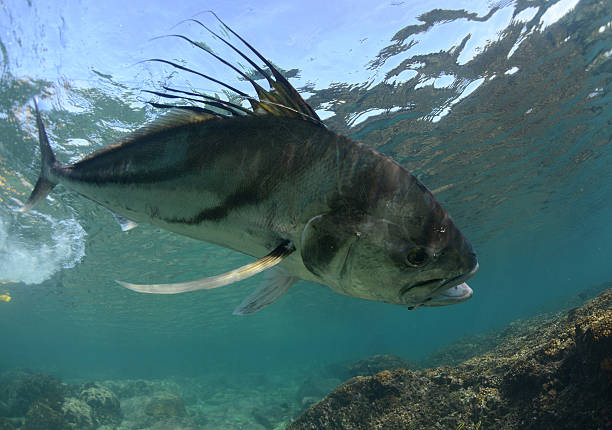The rooster fish (Nematistius pectoralis) is a distinctive and highly prized species in both sport fishing and culinary circles, renowned for its striking appearance, challenging fight, and unique ecological role. Recognized for the comb-like dorsal fin that gives it its name, the rooster fish inhabits warm tropical and subtropical waters, predominantly along the eastern Pacific coast from Baja California to Peru. Its popularity among anglers is driven not only by its impressive size, often exceeding 100 pounds, but also by its aggressive fighting behavior, making it a true test of skill, endurance, and strategy for sport fishing enthusiasts. The rooster fish is less common in commercial fisheries, which contributes to its rarity on menus, but its culinary qualities, including firm white meat, make it a desirable catch for recreational purposes. Understanding the rooster fish fully requires exploring its taxonomy, physical characteristics, behavior, feeding patterns, habitat preferences, fishing methods, culinary potential, and conservation concerns.
Rooster fish are typically associated with coastal and nearshore environments, where they can be found in sandy bottoms, rocky reefs, bays, and near river mouths. They are predators, feeding primarily on smaller fish and crustaceans, and are known for their schooling behavior, which makes them both a formidable presence and a challenging target for anglers. The dorsal fin of the rooster fish is elongated and striking, often rising up dramatically like a rooster’s comb when the fish is active, a feature that distinguishes it from other large coastal game fish. Its behavior and size make it a prized trophy, and many sport fishermen plan entire trips specifically targeting this species, often using specialized techniques such as live bait casting, trolling, or fly fishing.
Taxonomy and Physical Description
The rooster fish belongs to the family Nematistiidae, which is monotypic, containing only the genus Nematistius. Its distinct morphology makes it easily recognizable compared to other coastal game fish. The dorsal fin is one of its most prominent features, composed of seven flexible spines that resemble a rooster’s comb. These spines can be raised and lowered, providing the fish with dramatic visual signaling, particularly when hunting or evading predators.
The body of the rooster fish is streamlined and muscular, optimized for bursts of speed and agility. Coloration typically ranges from silvery-gray to darker olive tones on the dorsal side, with lighter silvery-white on the belly. Distinctive black bands or stripes run vertically across the body, providing camouflage among waves and nearshore structures. Adults commonly measure 3–4 feet in length, although exceptional specimens may reach 5 feet or more, with weights surpassing 100 pounds. The mouth is large and slightly protruding, adapted to capture fast-moving prey in nearshore waters.
Table 1: Rooster Fish Physical Characteristics
| Feature | Description |
|---|---|
| Family | Nematistiidae |
| Genus | Nematistius |
| Common Name | Rooster Fish |
| Max Length | 5 feet (1.5 meters) |
| Max Weight | 100+ pounds (45+ kg) |
| Body Color | Silver-gray to olive dorsal, white ventral |
| Distinctive Feature | Seven comb-like dorsal spines |
| Mouth | Large, slightly protruding, predatory |
Habitat and Distribution
Rooster fish are coastal dwellers, favoring warm, tropical waters of the eastern Pacific Ocean. They are commonly found from Baja California, Mexico, down to northern Peru, including waters surrounding Central American countries such as Costa Rica, Panama, and Nicaragua. This distribution aligns with areas rich in baitfish populations, which are essential for the rooster fish’s predatory lifestyle.
Preferred habitats include:
- Shallow coastal reefs and sandy bottoms
- Rocky outcroppings near the shore
- Bays, estuaries, and river mouths
- Areas with strong tidal flows, which concentrate prey species
Juvenile rooster fish tend to remain in shallower waters, where they are protected from large predators, whereas adults venture closer to deeper coastal waters but remain within nearshore zones. Their habitat selection is influenced by water temperature, prey abundance, and seasonal migration patterns, with most activity occurring in waters ranging from 70°F to 85°F (21°C to 29°C).
Behavior and Feeding Patterns
Rooster fish exhibit predatory and schooling behaviors, often forming small groups to hunt baitfish such as sardines, mullet, small jacks, and other small schooling fish. They are opportunistic feeders, striking quickly and aggressively, often leaping out of the water when hooked, making them a favorite among sport anglers.
Key behavioral characteristics include:
- Schooling: Juveniles form small schools for protection and foraging efficiency.
- Aggressive Hunting: Adults hunt near the surface, chasing baitfish in rapid bursts.
- Elusiveness: Their agility and bursts of speed make them difficult to catch.
- Jumping Behavior: When hooked, rooster fish are known for spectacular leaps and runs.
Feeding tends to peak during dawn and dusk, coinciding with low-light periods when prey are more vulnerable. Their diet primarily consists of small fish and occasionally crustaceans. Their predatory strategy is opportunistic, relying on speed and maneuverability to ambush prey.
Table 2: Rooster Fish Feeding Patterns
| Behavior | Description |
|---|---|
| Hunting Style | Aggressive predator, often near surface |
| Prey | Small fish (sardines, mullet, jacks), crustaceans |
| Feeding Times | Dawn and dusk |
| Grouping | Juveniles school; adults may hunt solo or in small groups |
| Predation Strategy | Quick ambush and burst-speed attacks |
Fishing Techniques for Rooster Fish
The rooster fish is one of the most sought-after sport fish due to its size, strength, and fighting ability. Anglers targeting rooster fish employ specific techniques to maximize their chances of success.
1. Live Bait Fishing
Live bait, such as small fish or shrimp, is often considered the most effective method. The bait is presented naturally near the surface or along structure where rooster fish hunt.
2. Lures and Artificial Baits
Surface poppers, jigs, and spoons are frequently used to mimic the movement of prey. Rooster fish respond to rapid, erratic lure movements, triggering predatory strikes.
3. Trolling
Slow trolling along the coastline allows anglers to cover more territory and locate active fish. Trolling requires robust tackle to handle the fish’s strength.
4. Fly Fishing
Experienced anglers may pursue rooster fish with fly rods, using large streamers to imitate baitfish. This method is highly challenging due to the fish’s size and speed.
Successful fishing requires strong tackle, including heavy-duty rods, reels with high drag capacity, and braided line, often rated for 30–50 pounds. Hook selection is equally important to prevent lost fish during the fight.
Culinary Value and Preparation
Although not commonly found in commercial markets due to limited catches, rooster fish offers firm, white flesh suitable for various cooking methods. Its taste is mild but rich, comparable to other large game fish like mahi-mahi or snapper. Popular preparation methods include:
- Grilling: Rooster fish steaks retain moisture and flavor when grilled over medium heat.
- Baking: Whole fish or fillets can be baked with herbs and citrus.
- Ceviche: Fresh fillets can be marinated in citrus juice for ceviche-style dishes.
- Pan-Seared: Fillets quickly seared in olive oil maintain tenderness.
Due to its relatively low commercial availability, many culinary enthusiasts enjoy rooster fish mainly in coastal areas where sport-caught fish are freshly prepared.
Table 3: Rooster Fish Culinary Uses
| Preparation Method | Description | Key Benefit |
|---|---|---|
| Grilling | Steaks or fillets over moderate heat | Retains moisture, smoky flavor |
| Baking | Whole fish or fillets in oven | Even cooking, gentle flavor |
| Ceviche | Marinated in citrus juice | Light, refreshing, raw preparation |
| Pan-Searing | Quick sear in oil | Crisp exterior, tender interior |
Conservation and Sustainability
Despite its popularity, the rooster fish is not classified as endangered, but it faces pressures from overfishing, habitat degradation, and climate change. Being largely a sport fish rather than a commercial staple has helped maintain its populations, but sustainable practices are vital.
Conservation Recommendations
- Catch-and-Release Fishing: Encouraged to maintain adult populations.
- Size Limits: Implementing legal size restrictions protects juvenile fish.
- Habitat Protection: Preserving mangroves, reefs, and coastal environments ensures prey availability.
- Responsible Angling Practices: Use of non-lead tackle and ethical handling techniques minimizes stress and injury.
Conservation efforts benefit both the ecosystem and the recreational fishing economy, maintaining the rooster fish as a prized sport species.
Comparison: Rooster Fish vs Other Game Fish
| Feature | Rooster Fish | Dorado (Mahi-Mahi) | Yellowfin Tuna |
|---|---|---|---|
| Max Size | 100+ lbs | 50–80 lbs | 400+ lbs |
| Habitat | Coastal, tropical | Coastal & offshore | Offshore, open ocean |
| Fighting Ability | High, spectacular leaps | Moderate, fast | Very high, sustained runs |
| Culinary Value | Mild, firm | Mild, delicate | Rich, meaty |
| Common Fishing Method | Live bait, lures | Trolling, lures | Trolling, trolling with bait |
FAQs
1. Where is the rooster fish commonly found?
Rooster fish are found along the eastern Pacific coast from Baja California to Peru, inhabiting nearshore tropical waters.
2. Why is it called “rooster fish”?
The name comes from its distinctive dorsal fin with comb-like spines resembling a rooster’s crest.
3. What is the best method to catch rooster fish?
Live bait fishing and surface lures are most effective due to their aggressive predatory behavior.
4. Can rooster fish be eaten safely?
Yes, the firm white flesh is mild and suitable for grilling, baking, or ceviche.
5. Is rooster fish endangered?
No, it is not endangered, but sustainable fishing practices are encouraged to maintain healthy populations.









